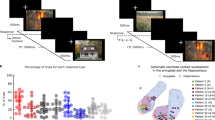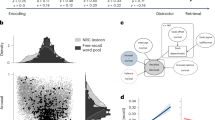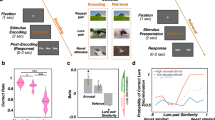Abstract
We have studied patients with variable degrees of left hippocampal and amygdala pathology who performed a verbal encoding task during functional magnetic resonance imaging (fMRI) to assess the impact of pathology on emotional-memory performance and encoding-evoked activity. The severity of left hippocampal pathology predicted memory performance for neutral and emotional items alike, whereas the severity of amygdala pathology predicted memory performance for emotional items alone. Encoding-related hippocampal activity for successfully remembered emotional items correlated with the degree of left amygdala pathology. Conversely, amygdala-evoked activity with respect to subsequently remembered emotional items correlated with the degree of left hippocampal pathology. Our data indicate a reciprocal dependence between amygdala and hippocampus during the encoding of emotional memories.
This is a preview of subscription content, access via your institution
Access options
Subscribe to this journal
Receive 12 print issues and online access
$209.00 per year
only $17.42 per issue
Buy this article
- Purchase on Springer Link
- Instant access to full article PDF
Prices may be subject to local taxes which are calculated during checkout





Similar content being viewed by others
References
Gallagher, M. & Chiba, A.A. The amygdala and emotion. Curr. Opin. Neurobiol. 6, 221–227 (1996).
Cahill, L. & McGaugh, J.L. Mechanisms of emotional arousal and lasting declarative memory. Trends Neurosci. 21, 294–299 (1998).
Dolan, R.J. Emotion, cognition and behavior. Science 298, 1191–1194 (2002).
Hamann, S.B., Ely, T.D., Grafton, S.T. & Kilts, C.D. Amygdala activity related to enhanced memory for pleasant and aversive stimuli. Nat. Neurosci. 2, 289–293 (1999).
Phelps, E.A., LaBar, K.S. & Spencer, D.D. Memory for emotional words following unilateral temporal lobectomy. Brain Cogn. 35, 85–109 (1997).
Adolphs, R., Cahill, L., Schul, R. & Babinsky, R. Impaired declarative memory for emotional material following bilateral amygdala damage in humans. Learn. Mem. 4, 291–300 (1997).
Strange, B.A., Henson, R.N., Friston, K.J. & Dolan, R.J. Brain mechanisms for detecting perceptual, semantic, and emotional deviance. Neuroimage 12, 425–433 (2000).
Cahill, L. et al. Amygdala activity at encoding correlated with long-term, free recall of emotional information. Proc. Natl. Acad. Sci. USA 93, 8016–8021 (1996).
McGaugh, J.L., Cahill, L. & Roozendaal, B. Involvement of the amygdala in memory storage: interaction with other brain systems. Proc. Natl. Acad. Sci. USA 93, 13508–13514 (1996).
Squire, L.R. & Zola-Morgan, S. The medial temporal lobe memory system. Science 253, 1380–1386 (1991).
Frisk, V. & Milner, B. The role of the left hippocampal region in the acquisition and retention of story content. Neuropsychologia 28, 349–359 (1990).
Smith, M.L. & Milner, B. The role of the right hippocampus in the recall of spatial location. Neuropsychologia 19, 781–793 (1981).
Alkire, M.T., Haier, R.J., Fallon, J.H. & Cahill, L. Hippocampal, but not amygdala, activity at encoding correlates with long-term, free recall of nonemotional information. Proc. Natl. Acad. Sci. USA 95, 14506–14510 (1998).
Duncan, J.S. Imaging and epilepsy. Brain 120, 376–389 (1997).
Woermann, F.G. et al. Regional changes in hippocampal T2 relaxation and volume: a quantitative magnetic resonance imaging study of hippocampal sclerosis. J. Neurol. Neurosurg. Psychiatry 65, 656–664 (1998).
Duncan, J.S., Bartlett, P. & Barker, G.J. Technique for measuring hippocampal T2 relaxation time. AJNR Am. J. Neuroradiol. 17, 1805–1810 (1996).
Van Paesschen, W. et al. Quantitative hippocampal MRI and intractable temporal lobe epilepsy. Neurology 45, 2233–2240 (1995).
Bartlett, P.A., Richardson, M.P. & Duncan, J.S. Measurement of amygdala T2 relaxation time in temporal lobe epilepsy. J. Neurol. Neurosurg. Psychiatry 73, 753–735 (2002).
Hudson, L.P. et al. Amygdaloid sclerosis in temporal lobe epilepsy. Ann. Neurol. 33, 622–631 (1993).
Helmstaedter, C. & Kurthen, M. Memory and epilepsy: characteristics, course, and influence of drugs and surgery. Curr. Opin. Neurol. 14, 211–216 (2001).
Ashburner, J. & Friston, K.J. Voxel-based morphometry—the methods. Neuroimage 11, 805–821 (2000).
Friston, K.J. et al. Event-related fMRI: characterizing differential responses. Neuroimage 7, 30–40 (1998).
Craik, F.I.M. & Lockhart, R.S. Levels of processing: A framework for memory. J. Verbal Learn. Verbal Behav. 11, 671–684 (1972).
Tulving, E. Memory and consciousness. Can. Psychol. 26, 1–12 (1985).
Windmann, S. & Kutas, M. Electrophysiological correlates of emotion-induced recognition bias. J. Cogn. Neurosci. 13, 577–592 (2001).
Richardson, M.P., Strange, B.A., Duncan, J.S. & Dolan, R.J. Preserved verbal memory function in left medial temporal pathology involves reorganisation of function to right medial temporal lobe. Neuroimage 20, S112–119 (2003).
Van Paesschen, W. et al. Quantitative neuropathology and quantitative magnetic resonance imaging of the hippocampus in temporal lobe epilepsy. Ann. Neurol. 42, 756–766 (1997).
Van Paesschen, W. et al. The spectrum of hippocampal sclerosis: a quantitative magnetic resonance imaging study. Ann. Neurol. 41, 41–51 (1997).
Kalviainen, R. et al. MRI-based hippocampal volumetry and T2 relaxometry: correlation to verbal memory performance in newly diagnosed epilepsy patients with left-sided temporal lobe focus. Neurology 48, 286–287 (1997).
Kilpatrick, C. et al. Degree of left hippocampal atrophy correlates with severity of neuropsychological deficits. Seizure 6, 213–218 (1997).
Lencz, T. et al. Quantitative magnetic resonance imaging in temporal lobe epilepsy: relationship to neuropathology and neuropsychological function. Ann. Neurol. 31, 629–637 (1992).
Briellmann, R.S., Kalnins, R.M., Berkovic, S.F. & Jackson, G.D. Hippocampal pathology in refractory temporal lobe epilepsy: T2-weighted signal change reflects dentate gliosis. Neurology 58, 265–271 (2002).
Golby, A.J. et al. Memory lateralization in medial temporal lobe epilepsy assessed by functional MRI. Epilepsia 43, 855–863 (2002).
Dupont, S. et al. Episodic memory in left temporal lobe epilepsy: a functional MRI study. Brain 123, 1722–1732 (2000).
Bellgowan, P.S. et al. Side of seizure focus predicts left medial temporal lobe activation during verbal encoding. Neurology 51, 479–484 (1998).
Richter-Levin, G. & Akirav, I. Amygdala-hippocampus dynamic interaction in relation to memory. Mol. Neurobiol. 22, 11–20 (2000).
Pitkanen, A., Pikkarainen, M., Nurminen, N. & Ylinen, A. Reciprocal connections between the amygdala and the hippocampal formation, perirhinal cortex, and postrhinal cortex in rat. A review. Ann. NY Acad. Sci. 911, 369–391 (2000).
van Groen, T . & Wyss, J.M. Extrinsic projections from area CA1 of the rat hippocampus: olfactory, cortical, subcortical, and bilateral hippocampal formation projections. J. Comp. Neurol. 302, 515–528 (1990).
Canteras, N.S. & Swanson, L.W. Projections of the ventral subiculum to the amygdala, septum, and hypothalamus: a PHAL anterograde tract-tracing study in the rat. J. Comp. Neurol. 324, 180–194 (1992).
Krettek, J.E. & Price, J.L. Projections from the amygdaloid complex and adjacent olfactory structures to the entorhinal cortex and to the subiculum in the rat and cat. J. Comp. Neurol. 172, 723–752 (1977).
Maren, S. & Fanselow, M.S. Synaptic plasticity in the basolateral amygdala induced by hippocampal formation stimulation in vivo. J. Neurosci. 15, 7548–7564 (1995).
Seidenbecher, T., Laxmi, T.R., Stork, O. & Pape, H.C. Amygdalar and hippocampal theta rhythm synchronization during fear memory retrieval. Science 301, 846–850 (2003).
Friston, K.J. et al. Statistical parametric maps in functional imaging: A general linear approach. Hum. Brain. Map. 2, 189–210 (1995).
Otten, L.J., Henson, R.N. & Rugg, M.D. Depth of processing effects on neural correlates of memory encoding: relationship between findings from across- and within-task comparisons. Brain 124, 399–412 (2001).
Acknowledgements
We would like to thank the clinicians of the Department of Clinical and Experimental Epilepsy (J. Duncan, L. Sander, M. Walker, H. Cock, S. Sisodiya and M. Koepp) for referring patients to the study and P. Bartlett, Chief Radiographer at the Chalfont Centre for Epilepsy, for providing the volume and T2 data. M.P.R. is funded by a fellowship of the Medical Research Council, UK. R.J.D. is supported by a Wellcome Trust Programme Grant.
Author information
Authors and Affiliations
Corresponding author
Ethics declarations
Competing interests
The authors declare no competing financial interests.
Supplementary information
Supplementary Fig. 1
Statistical parametric map (SPM) overlaid on sagittal and coronal sections of the average T1 image from all 16 patients studied. The highlighted voxels show a significant positive correlation between gray matter density and recognition accuracy for R responses to neutral items at P < 0.01 and a significant negative correlation between T2 signal and recognition accuracy for R responses to neutral items at P < 0.01. These are the only voxels in the entire brain to show both these effects. (JPG 16 kb)
Rights and permissions
About this article
Cite this article
Richardson, M., Strange, B. & Dolan, R. Encoding of emotional memories depends on amygdala and hippocampus and their interactions. Nat Neurosci 7, 278–285 (2004). https://doi.org/10.1038/nn1190
Received:
Accepted:
Published:
Issue Date:
DOI: https://doi.org/10.1038/nn1190
This article is cited by
-
Pre-scan state anxiety is associated with greater right amygdala-hippocampal response to fearful versus happy faces among trait-anxious Latina girls
BMC Psychiatry (2024)
-
Data-centric artificial olfactory system based on the eigengraph
Nature Communications (2024)
-
Long term structural and functional neural changes following a single infusion of Ketamine in PTSD
Neuropsychopharmacology (2023)
-
Effects of the suppression of 5-HT1A receptors in the left, right, or bilateral basolateral amygdala on memory consolidation in chronic stress in male rats
Naunyn-Schmiedeberg's Archives of Pharmacology (2023)
-
J147 ameliorates sepsis-induced depressive-like behaviors in mice by attenuating neuroinflammation through regulating the TLR4/NF-κB signaling pathway
Journal of Molecular Histology (2023)



